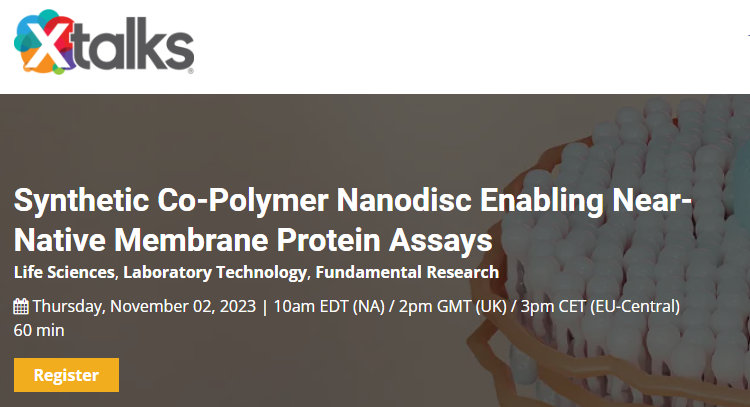The Utility of SMA Copolymers with Dr. David Swainsbury
The Intelligent Infusions Recap
It was once again Intelligent Infusions time. In October, Dr. David Swainsbury was the focus of our Masterclass series. Teaching biochemistry and microbiology at the University of East Anglia, Swainsbury's own research addresses topics in protein design, enzymology, protein purification, and cryo-EM.
To be more precise, his research centres on structural and functional studies of photosynthetic protein complexes to understand molecular mechanisms that convert light energy into useful chemical forms. Using the knowledge gained from his studies, he ultimately tries to engineer photosynthetic organisms that are more efficient in harvesting from the solar spectrum.
Slowly introducing us to his topic of photosynthetic membrane proteins, Dr. Swainsbury, leads his talk with the presentation of the model organism Rhodobacter sphaeroides. Going into further detail, he then follows with the four protein complexes required for the photosynthetic process. To better understand such processes, proteins are usually solubilized using a variety of methods. But underlying all these methods is the fact that the native environment of the membrane proteins is destroyed in the process. Swainsbury therefore decided to give the novel SMA copolymers a chance.
In the course of his masterclass, Dr. Swainsbury takes us through his successful work with the purple bacterial reaction center (RC), and later on the cytochrome bc1 complex. Among other things, he conducted studies on the biochemical characteristics of solubilization with SMA compared to detergents. But he was also able to draw conclusions about whether the solubilized proteins are in lipid-rich or protein-rich environments using SMA technology. What other insights he was able to gain, especially about the cytochrome bc1 complex, can now be reviewed at any time via the recording of his masterclass.
Are you also interested in Dr. Swainsbury's findings and what discussions have unfolded following this masterclass? Then just click on the button "Livestream" for the possibility of watching everything again at any time.
To be more precise, his research centres on structural and functional studies of photosynthetic protein complexes to understand molecular mechanisms that convert light energy into useful chemical forms. Using the knowledge gained from his studies, he ultimately tries to engineer photosynthetic organisms that are more efficient in harvesting from the solar spectrum.
Slowly introducing us to his topic of photosynthetic membrane proteins, Dr. Swainsbury, leads his talk with the presentation of the model organism Rhodobacter sphaeroides. Going into further detail, he then follows with the four protein complexes required for the photosynthetic process. To better understand such processes, proteins are usually solubilized using a variety of methods. But underlying all these methods is the fact that the native environment of the membrane proteins is destroyed in the process. Swainsbury therefore decided to give the novel SMA copolymers a chance.
In the course of his masterclass, Dr. Swainsbury takes us through his successful work with the purple bacterial reaction center (RC), and later on the cytochrome bc1 complex. Among other things, he conducted studies on the biochemical characteristics of solubilization with SMA compared to detergents. But he was also able to draw conclusions about whether the solubilized proteins are in lipid-rich or protein-rich environments using SMA technology. What other insights he was able to gain, especially about the cytochrome bc1 complex, can now be reviewed at any time via the recording of his masterclass.
Are you also interested in Dr. Swainsbury's findings and what discussions have unfolded following this masterclass? Then just click on the button "Livestream" for the possibility of watching everything again at any time.

DR. DAVID SWAINSBURY
Faculty of Science, University of East Anglia, GB
Biochemistry & MicrobiologyPhotosynthetic membrane proteins demonstrate the utility of SMA copolymers
KEY TAKEAWAYS
- Styrene maleic acid (SMA) copolymers create lipid nanodiscs directly from biological membranes, avoiding the need to use detergents.
- Work on model membrane proteins from the photosynthetic bacterium Rba. sphaeroides reveals that native structures and functions are retained in SMA nanodiscs
- Membrane proteins purified in SMA nanodiscs are amenable to biochemical characterisation, and structural determination by cryo-EM.
HIS RESEARCH
Dr Swainsbury’s research centres on structural and functional studies of photosynthetic protein complexes to understand the molecular mechanisms that convert light energy into useful chemical forms. The model membrane proteins that are central to his research have been invaluable to understand the mechanisms by which styrene maleic acid (SMA) copolymers produce lipid nanodiscs containing membrane protein complexes directly from cell membranes. His publications show how SMA retains the biochemical properties that are often lost when removing the protein from its membrane with detergents, how SMA can act as a probe for protein in lipid-rich or protein-rich domains, and most recently how SMA allows the structural characterisation of protein complexes that are labile in detergents to be determined by cryogenic electron microscopy.
RECENT PUBLICATION: Cryo-EM structure of the four-subunit Rhodobacter sphaeroides cytochrome bc1 complex in styrene maleic acid nanodiscs
KEYWORDS: Cryo-EM; Protein engineering; Protein design; Protein purification; Spectroscopy; Enzymology
KEYWORDS: Cryo-EM; Protein engineering; Protein design; Protein purification; Spectroscopy; Enzymology
Upcoming session
Our next session will be an Xtalks event with Dr. Felipe Merino. Dr. Mario Leutert from ETH Zurich will also join the event as moderator. In general, they will talk about possible ways of finding solubilization and stabilization conditions that preserve the native structure and function of membrane proteins. Register now if you are interested in learning more about these options and solutions.



